A Spatiotemporal Dilated Convolutional Generative Network for Point-Of-Interest Recommendation
Abstract
1. Introduction
- We proposed a novel POI recommendation framework based on WaveNet model, where the conditional generative model and dilated causal convolutions are used to enable much larger receptive fields and model complex long-range check-in sequence. The framework not only achieves higher recommendation performance, but also appears to have a lower level of model complexity compared to the identified state-of-the-art POI recommendation methods.
- Considering the importance of spatiotemporal contextual information, we acquire the user’s personalized spatial preference by modeling continuous geographical distances, and capture the user’s personalized temporal preference by modeling specific continuous time IDs, which integrated patterns in two time scales (e.g., hours in a day and days in a week).
- We conducted experiments to study the spatiotemporal characteristics of users’ check-in behavior on two real-world datasets, and we compared ST-DCGN with seven baseline approaches of POI recommendation, and extensive experiments showed that ST-DCGN was effective and outperforms state-of-the-art methods significantly.
2. Related Work
2.1. Conventional POI Recommendation Methods
2.2. Deep Learning-Based POI Recommendation Methods
3. Proposed Method
3.1. Problem Formulation
3.2. Personalized Spatiotemporal Preference
3.2.1. Personalized Spatial Preference
3.2.2. Personalized Temporal Preference
3.3. A Generative Model under Spatiotemporal Conditions
3.4. Embedding Look-Up Layer
3.5. Dilated Causal Convolutions Layer
3.6. Final Layer and Network Training
4. Experimental Results and Analysis
4.1. Datasets Description and Analysis
4.2. Baseline Approaches
- Bayesian Personalized Ranking (BPR): This work presents the generic optimization criterion BPR-OPT derived from the maximum posterior estimator for optimal personalized ranking [51]. BPR is a classic baseline method for general POI recommendation.
- GRU: RNN is effective for POI recommendation task, and we applied an extension of RNN called GRU for capturing the long-term dependency [52].
- FPMC-LR: A state-of-the-art Markov chain method for POI recommendation. This method is designed based on first-order Markov chain and uses neighbors as negative samples [18].
- PRME-G: A state-of-the-art metric embedding method for POI recommendation, and the spatial distance is considered as the weight [12].
- Caser: A state-of-the-art standard 2D CNN-based method for personalized top-N sequential recommendation [45], and we applied Caser in POI recommendation.
- Distance2Pre: A state-of-the-art GRU-based model for POI prediction, which acquires the spatial preference by modeling distances between successive POIs [13].
- ST-RNN: A state-of-the-art RNN-based model for POI recommendation [19], which incorporates both local temporal and spatial transition context.
4.3. Evaluation Metrics and Experiment Setup
4.4. Recommendation Performance
4.5. Sensitive Analysis of Parameters
5. Conclusions and Future Work
Author Contributions
Funding
Conflicts of Interest
References
- Gao, H.; Tang, J.; Liu, H. Exploring social-historical ties on location-based social networks. In Proceedings of the Sixth International AAAI Conference on Weblogs and Social Media, Dublin, Ireland, 4–7 June 2012. [Google Scholar]
- Ding, R.; Chen, Z. RecNet: A deep neural network for personalized POI recommendation in location-based social networks. Int. J. Geogr. Inf. Sci. 2018, 32, 1631–1648. [Google Scholar] [CrossRef]
- Majid, A.; Chen, L.; Chen, G.; Mirza, H.T.; Hussain, I.; Woodward, J. A context-aware personalized travel recommendation system based on geotagged social media data mining. Int. J. Geogr. Inf. Sci. 2018, 27, 662–684. [Google Scholar] [CrossRef]
- Wan, L.; Hong, Y.; Huang, Z.; Peng, X.; Li, R. A hybrid ensemble learning method for tourist route recommendations based on geo-tagged social networks. Int. J. Geogr. Inf. Sci. 2018, 32, 2225–2246. [Google Scholar] [CrossRef]
- Li, X.; Cong, G.; Li, X.L.; Pham, T.A.N.; Krishnaswamy, S. Rank-geofm: A ranking based geographical factorization method for point of interest recommendation. In Proceedings of the 38th International ACM SIGIR Conference on Research and Development in Information Retrieval, Santiago, Chile, 9–13 August 2015; pp. 433–442. [Google Scholar]
- Ye, M.; Yin, P.; Lee, W.C.; Lee, D.L. Exploiting geographical influence for collaborative point-of-interest recommendation. In Proceedings of the 34th International ACM SIGIR Conference on Research and Development in Information Retrieval, Beijing, China, 24–28 July 2011; pp. 325–334. [Google Scholar]
- Yuan, Q.; Cong, G.; Ma, Z.; Sun, A.; Thalmann, N.M. Time-aware point-of-interest recommendation. In Proceedings of the 36th International ACM SIGIR Conference on Research and Development in Information Retrieval, Dublin, Ireland, 28 July–1 August 2013; pp. 363–372. [Google Scholar]
- Cai, L.; Xu, J.; Liu, J.; Pei, T. Integrating spatial and temporal contexts into a factorization model for POI recommendation. Int. J. Geogr. Inf. Sci. 2018, 32, 524–546. [Google Scholar] [CrossRef]
- Gan, M.; Gao, L. Discovering Memory-Based Preferences for POI Recommendation in Location-Based Social Networks. ISPRS Int. J. Geo-Inf. 2019, 8, 279. [Google Scholar] [CrossRef]
- Huang, L.; Ma, Y.; Wang, S.; Liu, Y. An Attention-based Spatiotemporal LSTM Network for Next POI Recommendation. IEEE Trans. Serv. Comput. 2019, 99. [Google Scholar] [CrossRef]
- Tobler, W.R. A computer movie simulating urban growth in the Detroit region. Econ. Geogr. 1970, 46, 234–240. [Google Scholar] [CrossRef]
- Feng, S.; Li, X.; Zeng, Y.; Cong, G.; Chee, Y.M.; Yuan, Q. Personalized ranking metric embedding for next new POI recommendation. In Proceedings of the Twenty-Fourth International Joint Conference on Artificial Intelligence, Buenos Aires, Argentina, 25–31 July 2015. [Google Scholar]
- Cui, Q.; Tang, Y.; Wu, S.; Wang, L. Distance2Pre: Personalized Spatial Preference for Next Point-of-Interest Prediction. In Proceedings of the Pacific-Asia Conference on Knowledge Discovery and Data Mining, Macau, China, 14–17 April 2019; pp. 289–301. [Google Scholar]
- Gao, H.; Tang, J.; Hu, X.; Liu, H. Exploring temporal effects for location recommendation on location-based social networks. In Proceedings of the 7th ACM Conference on Recommender Systems, Hong Kong, China, 12–16 October 2013; pp. 93–100. [Google Scholar]
- Kefalas, P.; Manolopoulos, Y. A time-aware spatio-textual recommender system. Expert. Syst. Appl. 2017, 78, 396–406. [Google Scholar] [CrossRef]
- Wang, W.; Yin, H.; Du, X.; Nguyen, Q.V.H.; Zhou, X. TPM: A temporal personalized model for spatial item recommendation. ACM Trans. Intell. Syst. Technol. 2018, 9, 1–25. [Google Scholar] [CrossRef]
- Cheng, C.; Yang, H.; King, I.; Lyu, M.R. Fused matrix factorization with geographical and social influence in location-based social networks. In Proceedings of the Twenty-Sixth AAAI Conference on Artificial Intelligence, Toronto, ON, Canada, 22–26 July 2012. [Google Scholar]
- Cheng, C.; Yang, H.; Lyu, M.R.; King, I. Where you like to go next: Successive point-of-interest recommendation. In Proceedings of the Twenty-Third International Joint Conference on Artificial Intelligence, Beijing, China, 3–19 August 2013. [Google Scholar]
- Liu, Q.; Wu, S.; Wang, L.; Tan, T. Predicting the next location: A recurrent model with spatial and temporal contexts. In Proceedings of the Thirtieth AAAI Conference on Artificial Intelligence, Phoenix, AZ, USA, 12–17 February 2016. [Google Scholar]
- Zhao, P.; Zhu, H.; Liu, Y.; Li, Z.; Xu, J.; Sheng, V.S. Where to Go Next: A Spatio-temporal LSTM model for Next POI Recommendation. arXiv 2018, arXiv:1806.06671. [Google Scholar]
- Liu, C.; Liu, J.; Wang, J.; Xu, S.; Han, H.; Chen, Y. An Attention-Based Spatiotemporal Gated Recurrent Unit Network for Point-of-Interest Recommendation. ISPRS Int. J. Geo Inf. 2019, 8, 355. [Google Scholar] [CrossRef]
- Yuan, F.; Karatzoglou, A.; Arapakis, I.; Jose, J.M.; He, X. A Simple Convolutional Generative Network for Next Item Recommendation. In Proceedings of the Twelfth ACM International Conference on Web Search and Data Mining, Melbourne, Australia, 11–15 February 2019; pp. 582–590. [Google Scholar]
- Oord, A.V.D.; Dieleman, S.; Zen, H.; Simonyan, K.; Vinyals, O.; Graves, A.; Kalchbrenner, N.; Senior, A.; Kavukcuoglu, K. Wavenet: A generative model for raw audio. arXiv 2016, arXiv:1609.03499. [Google Scholar]
- Yang, D.; Zhang, D.; Zheng, V.W.; Yu, Z. Modeling user activity preference by leveraging user spatial temporal characteristics in LBSNs. IEEE Trans. Syst. Man Cybern. Syst. 2014, 45, 129–142. [Google Scholar] [CrossRef]
- Chang, B.; Park, Y.; Park, D.; Kim, S.; Kang, J. Content-Aware Hierarchical Point-of-Interest Embedding Model for Successive POI Recommendation. In Proceedings of the Program Committee of the 27th International Joint Conference on Artificial Intelligence, Stockholm, Sweden, 13–19 July 2019; pp. 3301–3307. [Google Scholar]
- Lian, D.; Zhao, C.; Xie, X.; Sun, G.; Chen, E.; Rui, Y. GeoMF: Joint geographical modeling and matrix factorization for point-of-interest recommendation. In Proceedings of the 20th ACM SIGKDD International Conference on Knowledge Discovery and Data Mining, New York, NY, USA, 24–27 August 2014; pp. 831–840. [Google Scholar]
- Kurashima, T.; Iwata, T.; Hoshide, T.; Takaya, N.; Fujimura, K. Geo topic model: Joint modeling of user’s activity area and interests for location recommendation. In Proceedings of the Sixth ACM International Conference on Web Search and Data Mining, Rome, Italy, 4–8 February 2013; pp. 375–384. [Google Scholar]
- Zhang, J.D.; Chow, C.Y. iGSLR: Personalized geo-social location recommendation: A kernel density estimation approach. In Proceedings of the 21st ACM SIGSPATIAL International Conference on Advances in Geographic Information Systems, Orlando, FL, USA, 5–8 November 2013; pp. 334–343. [Google Scholar]
- Li, H.; Ge, Y.; Hong, R.; Zhu, H. Point-of-interest recommendations: Learning potential check-ins from friends. In Proceedings of the 22nd ACM SIGKDD International Conference on Knowledge Discovery and Data Mining, Hilton Hotel, San Francisco, CA, USA, 13–17 August 2016; pp. 975–984. [Google Scholar]
- Yang, D.; Zhang, D.; Yu, Z.; Wang, Z. A sentiment-enhanced personalized location recommendation system. In Proceedings of the 24th ACM Conference on Hypertext and Social Media, Paris, France, 1–3 May 2013; pp. 119–128. [Google Scholar]
- Mathew, W.; Raposo, R.; Martins, B. Predicting future locations with hidden Markov models. In Proceedings of the 2012 ACM Conference on Ubiquitous Computing, Pittsburgh, PA, USA, 5–8 September 2012; pp. 911–918. [Google Scholar]
- Krizhevsky, A.; Sutskever, I.; Hinton, G.E. ImageNet classification with deep convolutional neural networks. Adv. Neural Inf. Proc. Syst. 2012, 60, 1097–1105. [Google Scholar] [CrossRef]
- He, K.; Zhang, X.; Ren, S.; Sun, J. Deep residual learning for image recognition. In Proceedings of the IEEE Conference on Computer Vision and Pattern Recognition, Las Vegas, NV, USA, 27–30 June 2016; pp. 770–778. [Google Scholar]
- Irsoy, O.; Cardie, C. Deep recursive neural networks for compositionality in language. In Proceedings of the 27th International Conference on Neural Information Processing Systems, Montreal, QC, Canada, 8–13 December 2014; pp. 2096–2104. [Google Scholar]
- Dong, L.; Yang, N.; Wang, W.; Wei, F.; Liu, X.; Wang, Y.; Hon, H.W. Unified Language Model Pre-training for Natural Language Understanding and Generation. arXiv 2019, arXiv:1905.03197. [Google Scholar]
- Hinton, G.; Deng, L.; Yu, D.; Dahl, G.; Mohamed, A.R.; Jaitly, N.; Sainath, T. Deep neural networks for acoustic modeling in speech recognition. IEEE Signal. Proc. Mag. 2012, 29, 82–97. [Google Scholar] [CrossRef]
- Amodei, D.; Ananthanarayanan, S.; Anubhai, R.; Bai, J.; Battenberg, E.; Case, C.; Chen, J. Deep speech 2: End-to-end speech recognition in English and Mandarin. In Proceedings of the 33rd International Conference on International Conference on Machine Learning, New York, NY, USA, 19–24 June 2016; pp. 173–182. [Google Scholar]
- Zhang, S.; Yao, L.; Sun, A.; Tay, Y. Deep learning based recommender system: A survey and new perspectives. ACM Comput. Surv. 2019, 52, 5. [Google Scholar] [CrossRef]
- Mikolov, T.; Sutskever, I.; Chen, K.; Corrado, G.S.; Dean, J. Distributed representations of words and phrases and their compositionality. In Proceedings of the 26th International Conference on Neural Information Processing Systems, Lake Tahoe, NV, USA, 5–10 December 2013; pp. 3111–3119. [Google Scholar]
- Liu, X.; Liu, Y.; Li, X. Exploring the Context of Locations for Personalized Location Recommendations. In Proceedings of the Twenty-Fifth International Joint Conference on Artificial Intelligence, New York, NY, USA, 9–15 July 2016; pp. 1188–1194. [Google Scholar]
- Feng, S.; Cong, G.; An, B.; Chee, Y.M. Poi2vec: Geographical latent representation for predicting future visitors. In Proceedings of the Thirty-First AAAI Conference on Artificial Intelligence, San Francisco, CA, USA, 4–9 February 2017. [Google Scholar]
- Kong, D.; Wu, F. HST-LSTM: A Hierarchical Spatial-Temporal Long-Short Term Memory Network for Location Prediction. In Proceedings of the 27th International Joint Conference on Artificial Intelligence, Stockholm, Sweden, 13–19 July 2018; pp. 2341–2347. [Google Scholar]
- Feng, J.; Li, Y.; Zhang, C.; Sun, F.; Meng, F.; Guo, A.; Jin, D. Deepmove: Predicting human mobility with attentional recurrent networks. In Proceedings of the 2018 World Wide Web Conference on World Wide Web, Lyon, France, 23–27 April 2018; pp. 1459–1468. [Google Scholar]
- Wang, S.; Wang, Y.; Tang, J.; Shu, K.; Ranganath, S.; Liu, H. What your images reveal: Exploiting visual contents for point-of-interest recommendation. In Proceedings of the 26th International Conference on World Wide Web, Perth, Australia, 3–7 April 2017; pp. 391–400. [Google Scholar]
- Tang, J.; Wang, K. Personalized top-n sequential recommendation via convolutional sequence embedding. In Proceedings of the Eleventh ACM International Conference on Web Search and Data Mining, Los Angeles, CA, USA, 5–9 February 2018; pp. 565–573. [Google Scholar]
- Oord, A.V.D.; Kalchbrenner, N.; Kavukcuoglu, K. Pixel recurrent neural networks. arXiv 2016, arXiv:1601.06759. [Google Scholar]
- He, K.; Zhang, X.; Ren, S.; Sun, J. Identity mappings in deep residual networks. In European conference on computer vision. In Proceedings of the European Conference on Computer Vision; Amsterdam, The Netherlands, 11–14 October 2016, pp. 630–645.
- Ba, J.L.; Kiros, J.R.; Hinton, G.E. Layer normalization. arXiv 2016, arXiv:1607.06450. [Google Scholar]
- Nair, V.; Hinton, G.E. Rectified linear units improve restricted Boltzmann machines. In Proceedings of the 27th International Conference on Machine Learning, Haifa, Israel, 21–24 June 2010; pp. 807–814. [Google Scholar]
- Jean, S.; Cho, K.; Memisevic, R.; Bengio, Y. On using very large target vocabulary for neural machine translation. arXiv 2014, arXiv:1412.2007. [Google Scholar]
- Rendle, S.; Freudenthaler, C.; Gantner, Z.; Schmidt-Thieme, L. BPR: Bayesian personalized ranking from implicit feedback. In Proceedings of the Twenty-Fifth Conference on Uncertainty in Artificial Intelligence, Montreal, QC, Canada, 18–21 June 2009; pp. 452–461. [Google Scholar]
- Cho, K.; Van Merriënboer, B.; Gulcehre, C.; Bahdanau, D.; Bougares, F.; Schwenk, H.; Bengio, Y. Learning phrase representations using RNN encoder-decoder for statistical machine translation. arXiv 2014, arXiv:1406.1078. [Google Scholar]
- Ayala-Gómez, F.; Daróczy, B.Z.; Mathioudakis, M.; Benczúr, A.; Gionis, A. Where could we go? Recommendations for groups in location-based social networks. In Proceedings of the 2017 ACM on Web Science Conference, Troy, NY, USA, 25–28 June 2017; pp. 93–102. [Google Scholar]
- Rendle, S.; Zhang, L.; Koren, Y. On the difficulty of evaluating baselines: A study on recommender systems. arXiv 2019, arXiv:1905.01395. [Google Scholar]
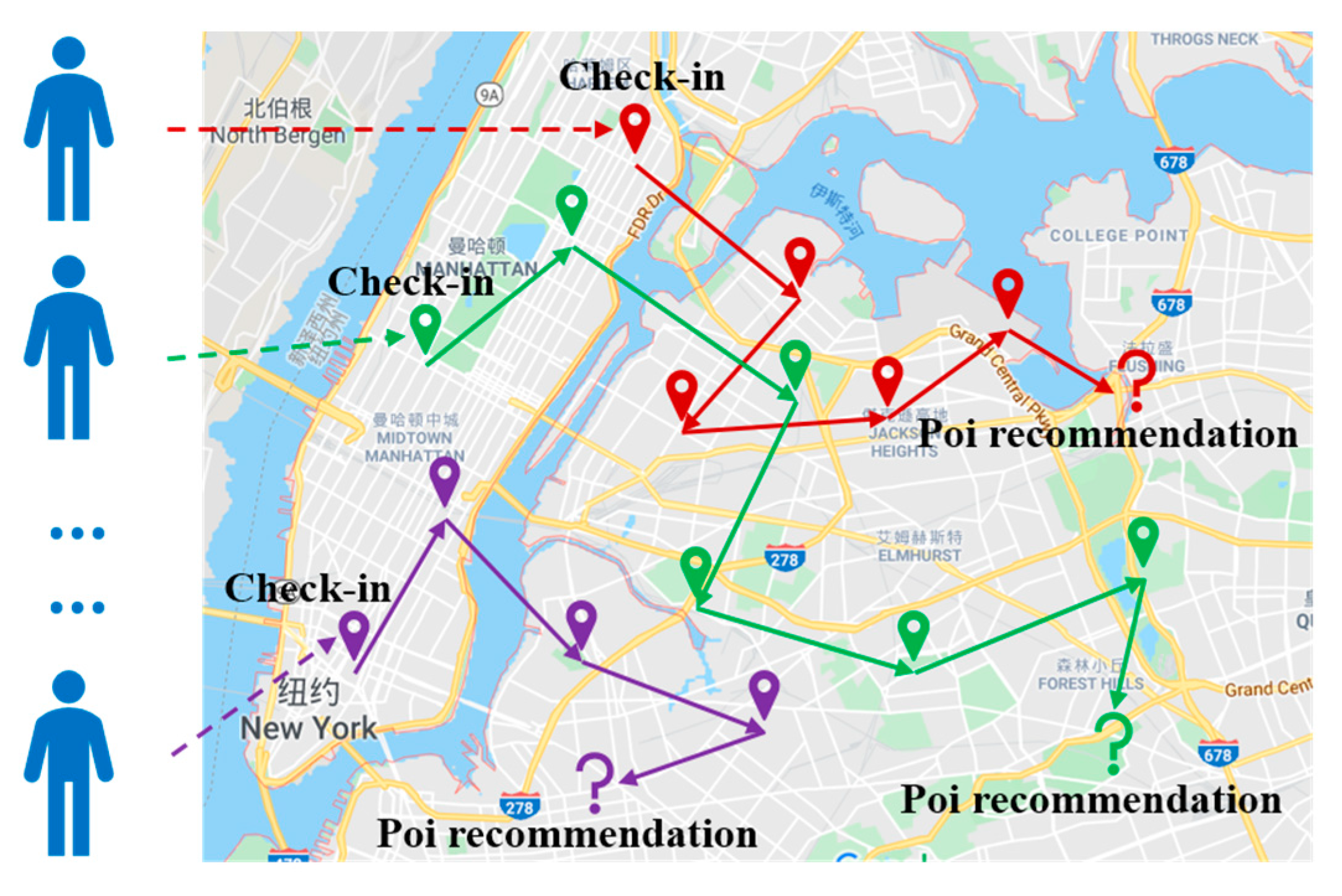
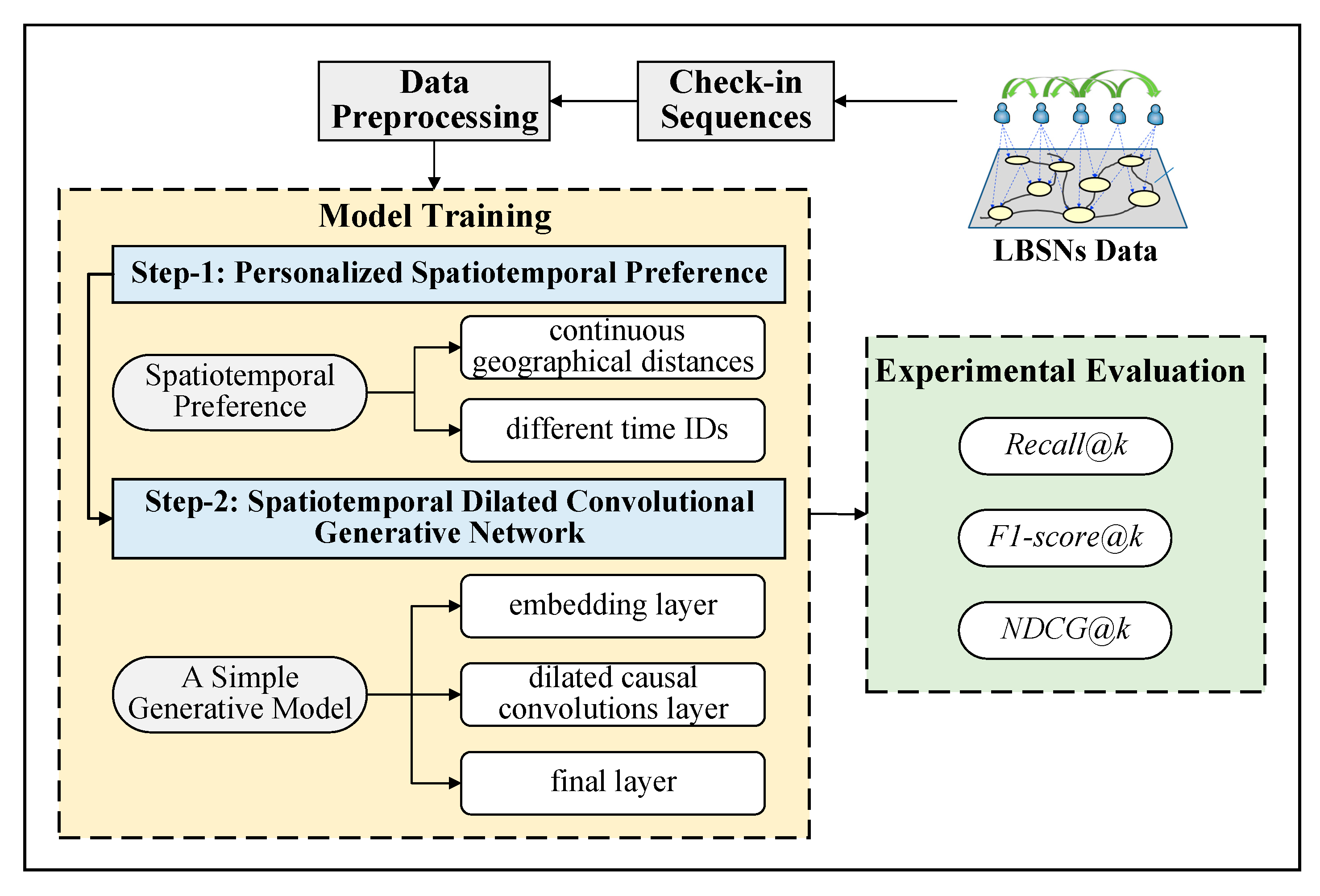

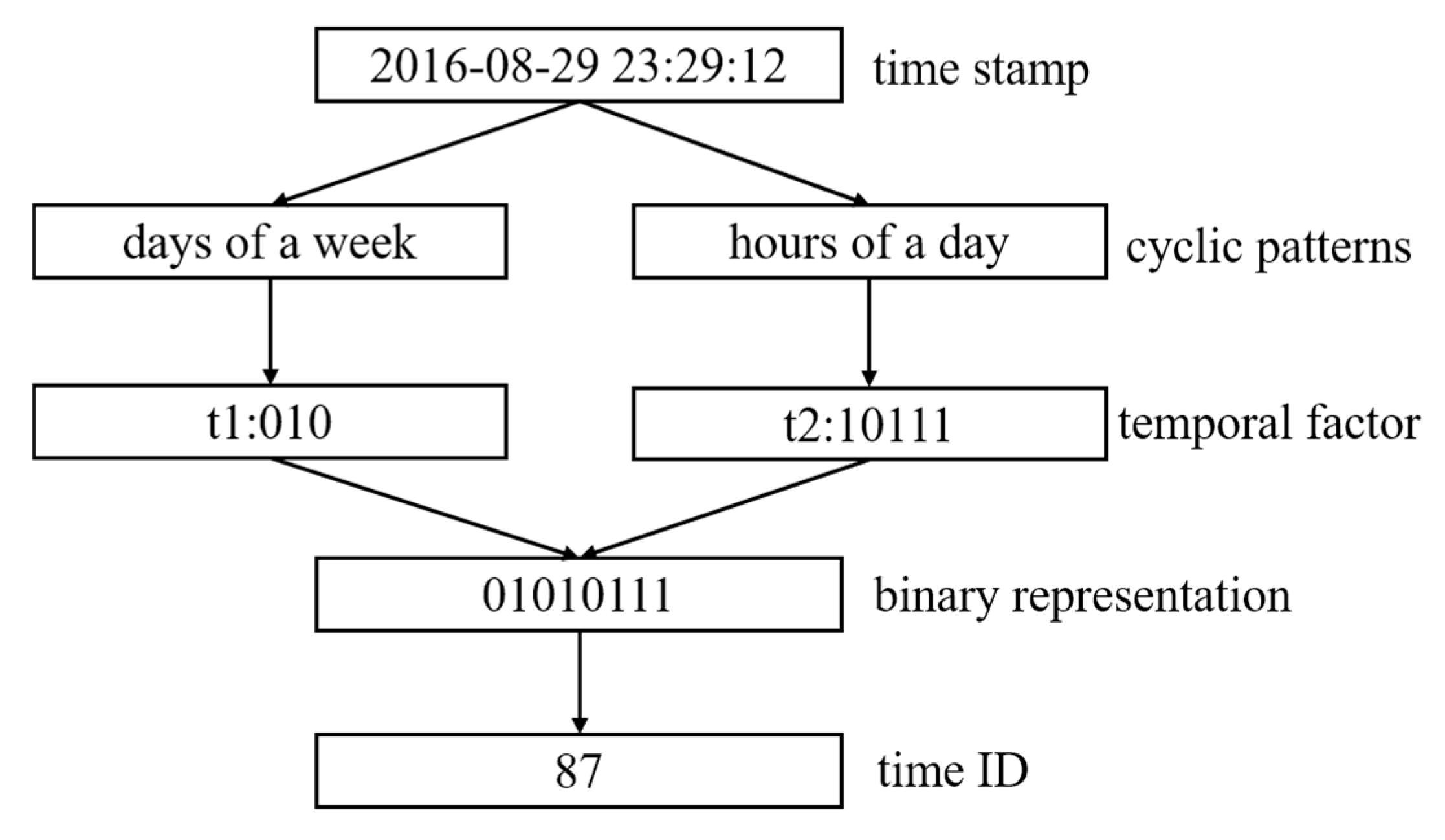
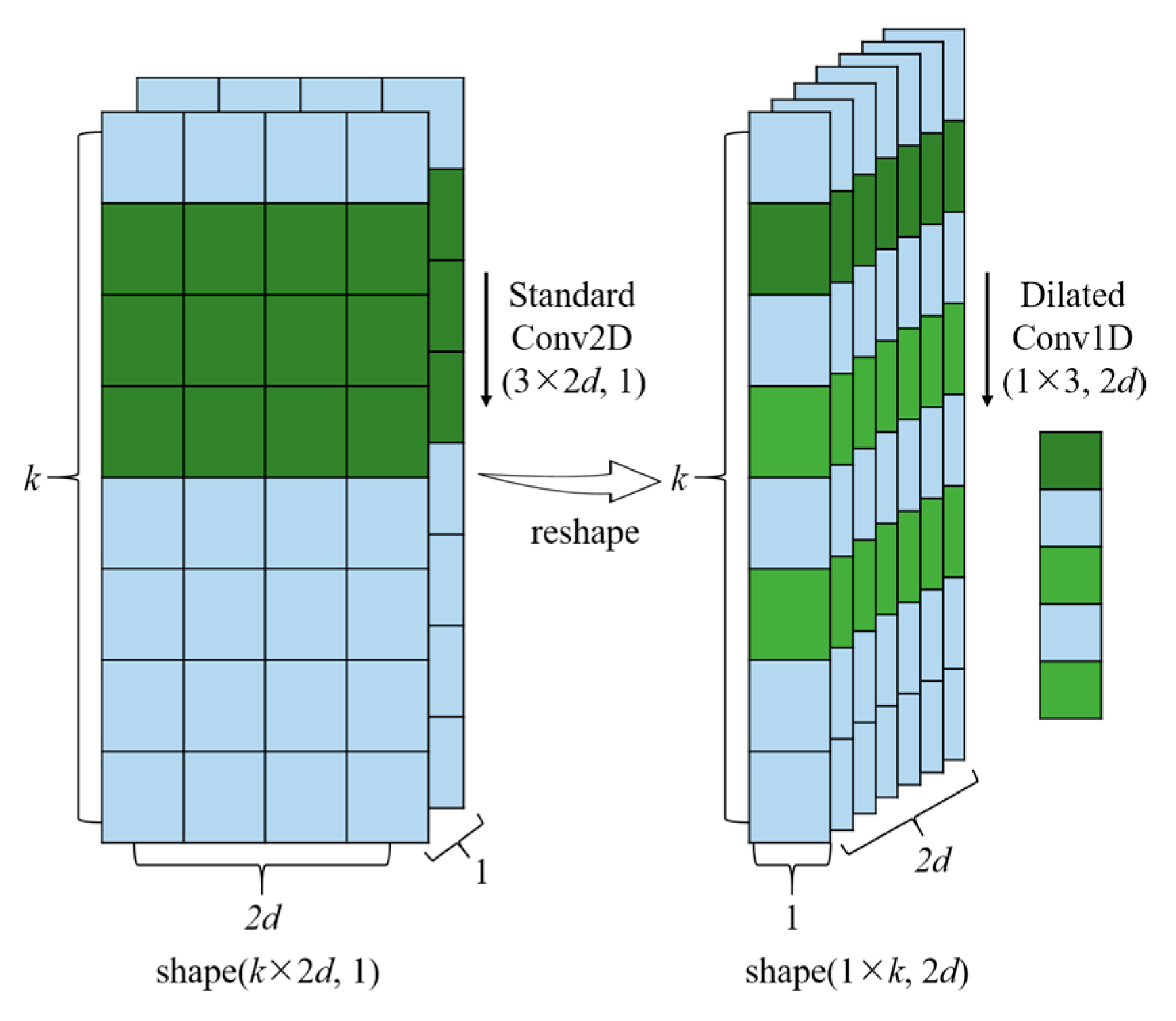
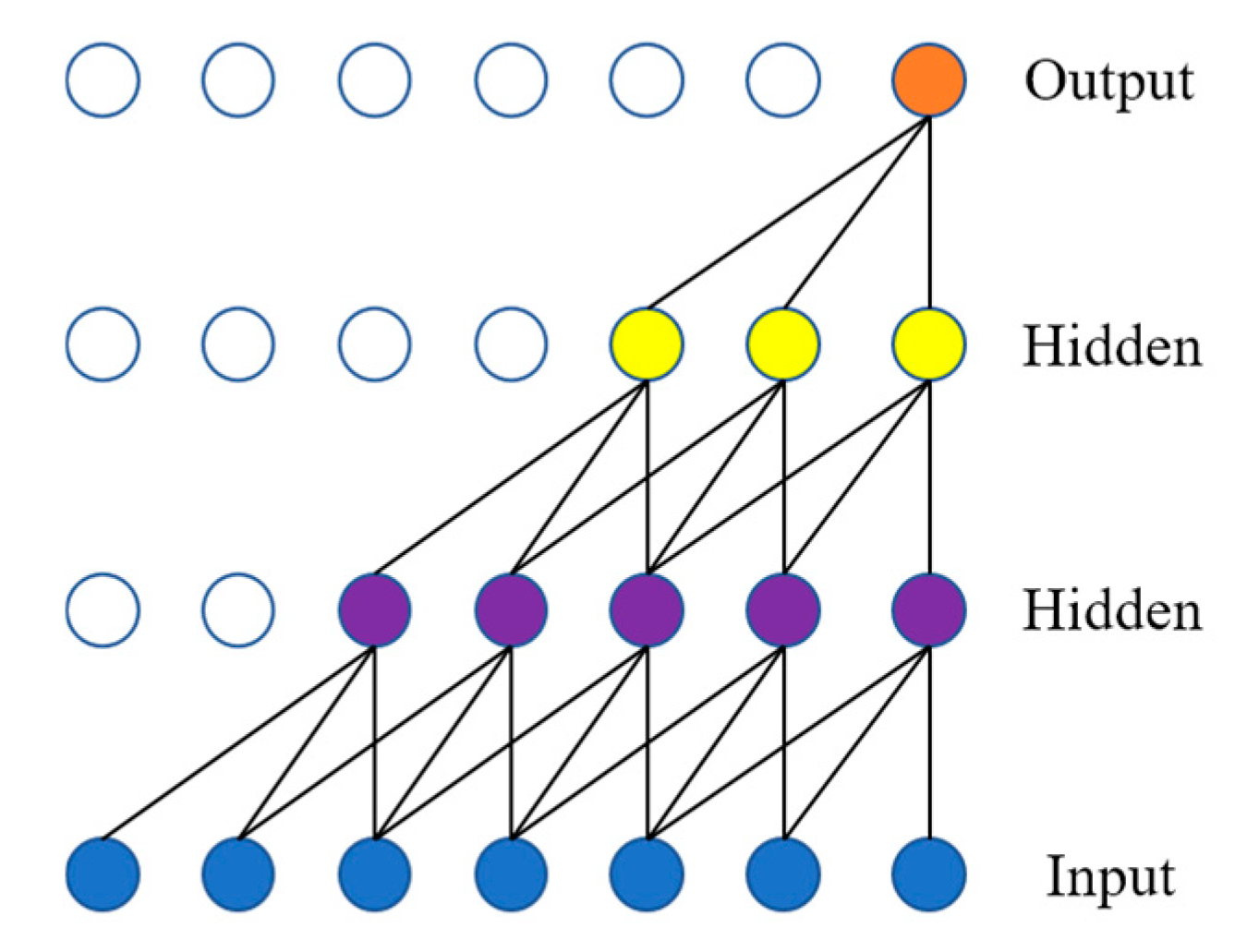
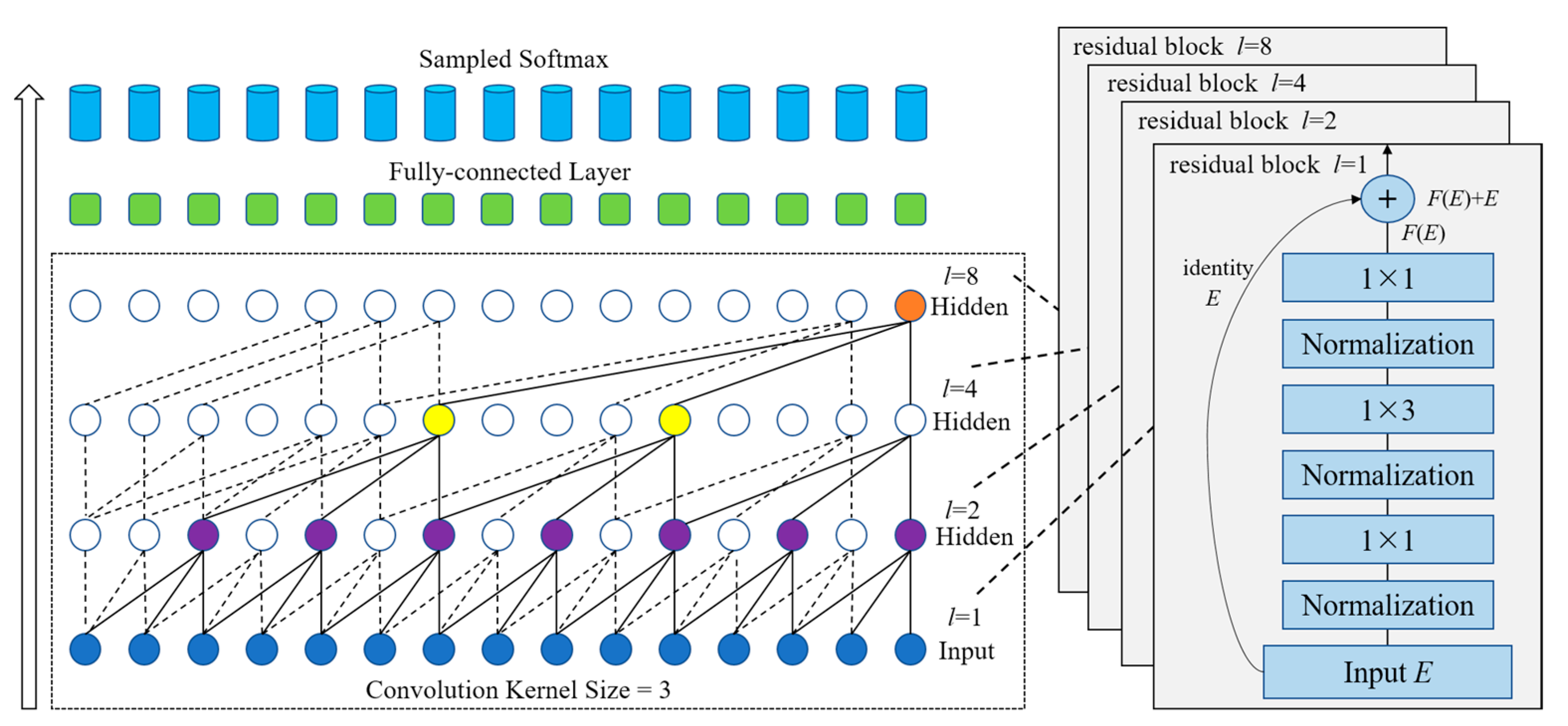
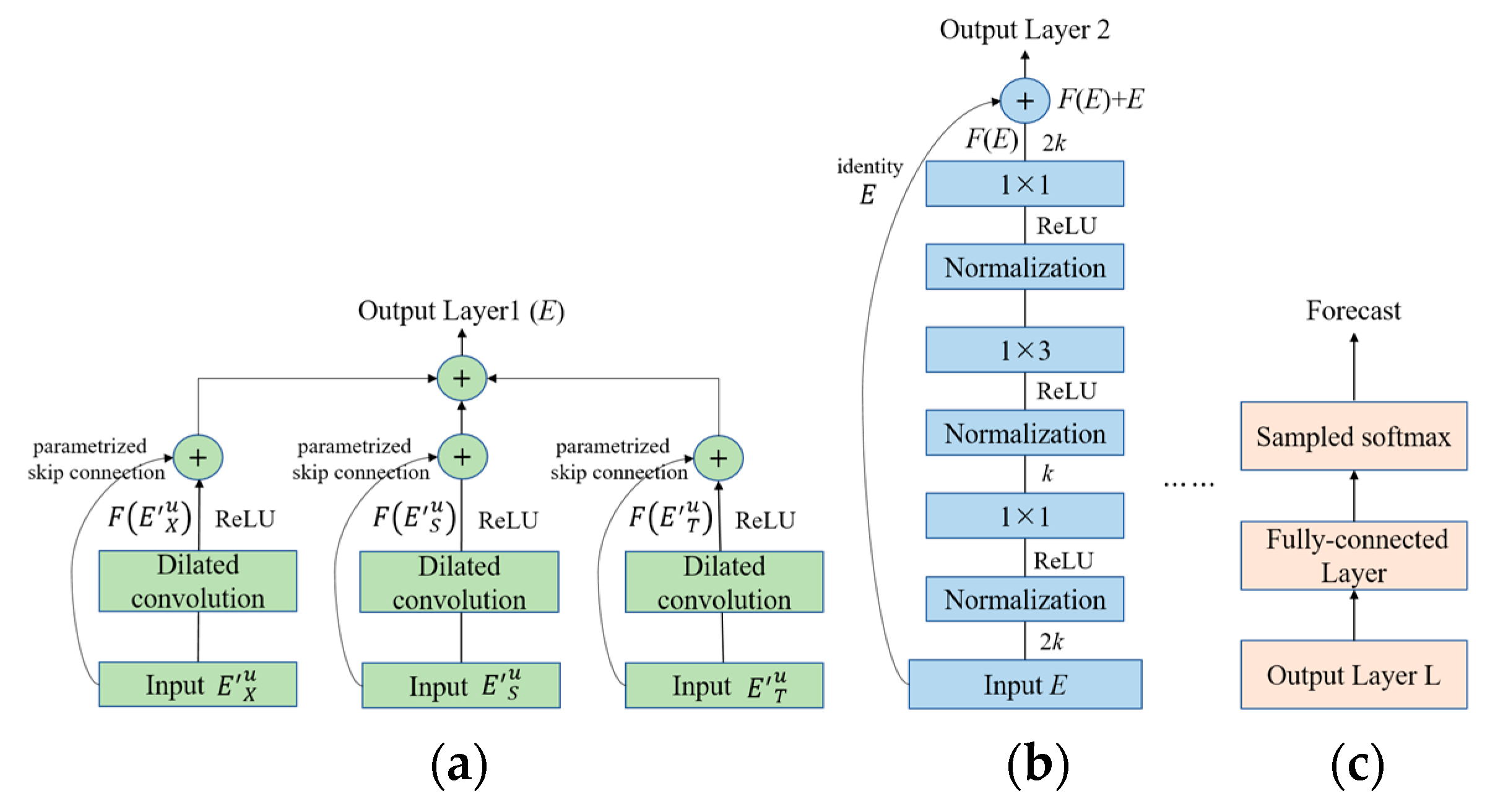
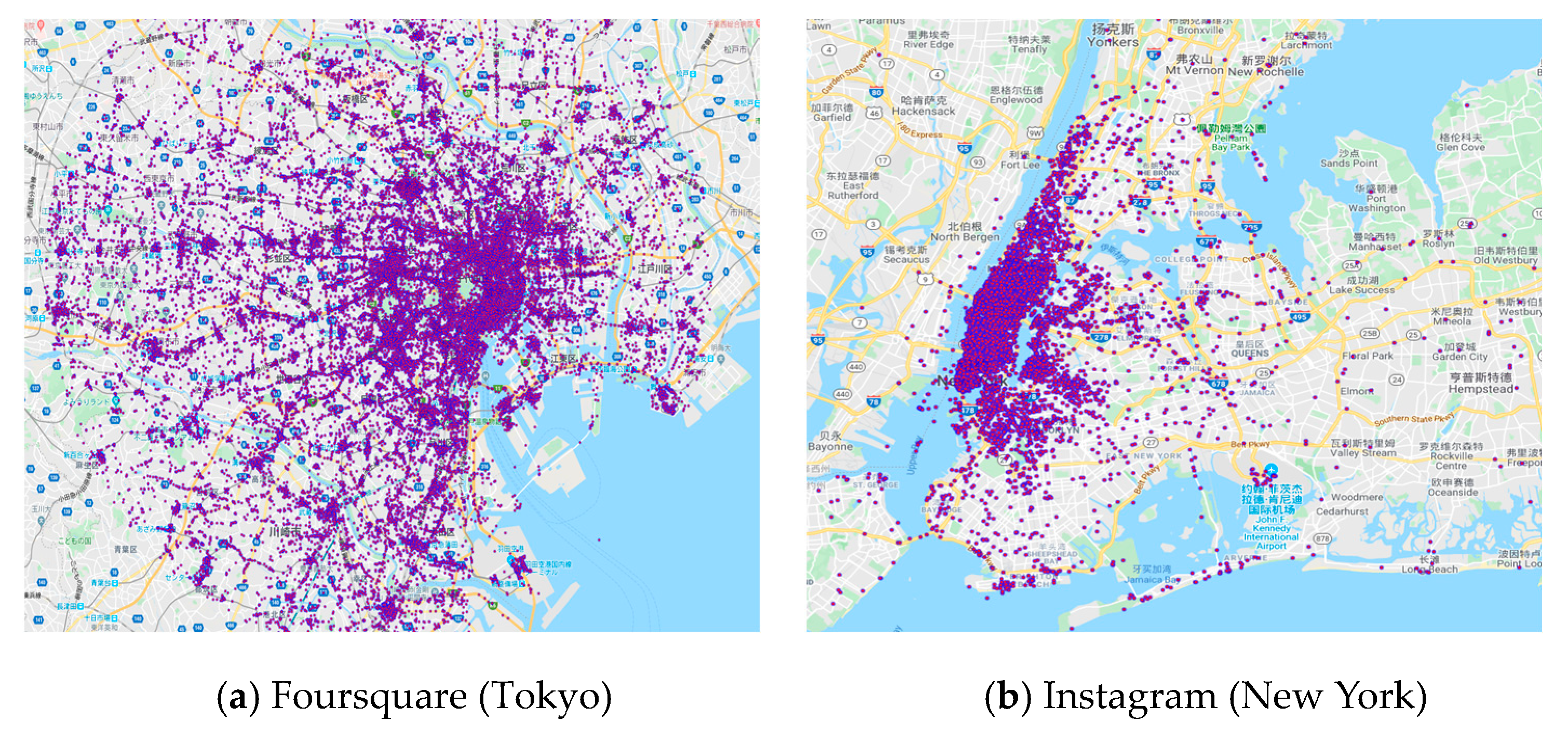
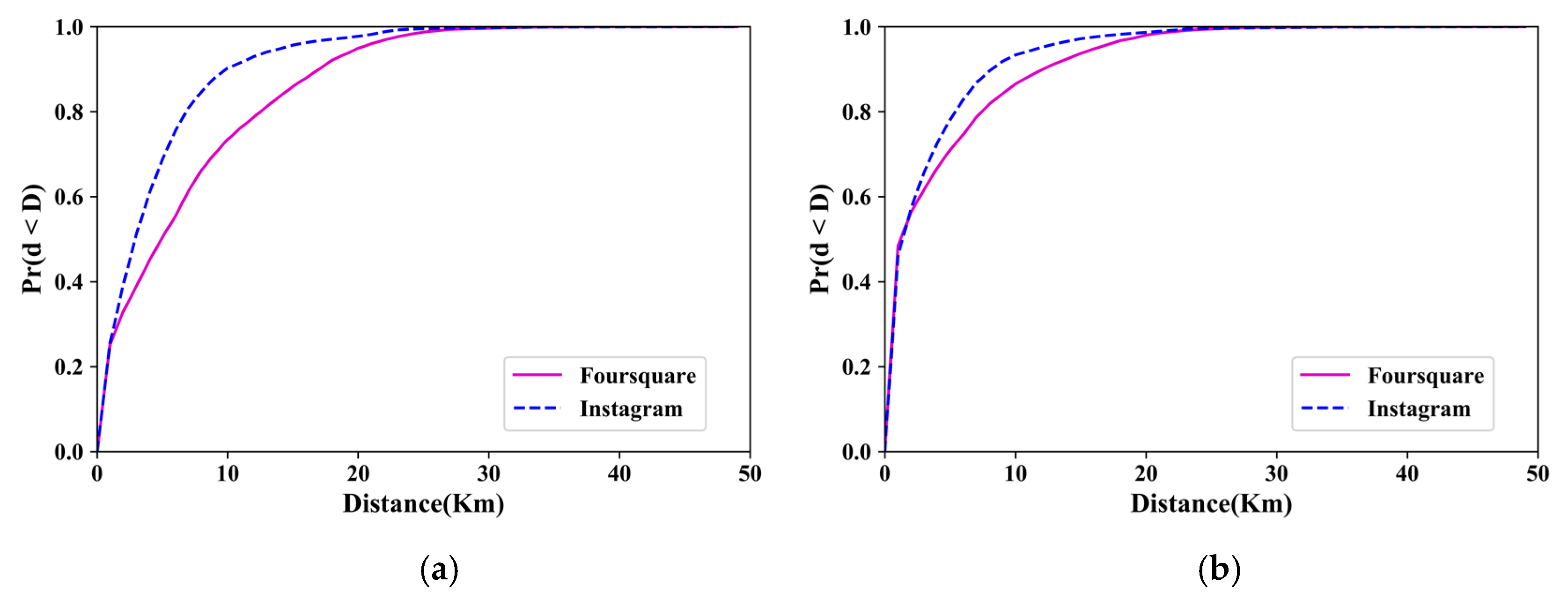



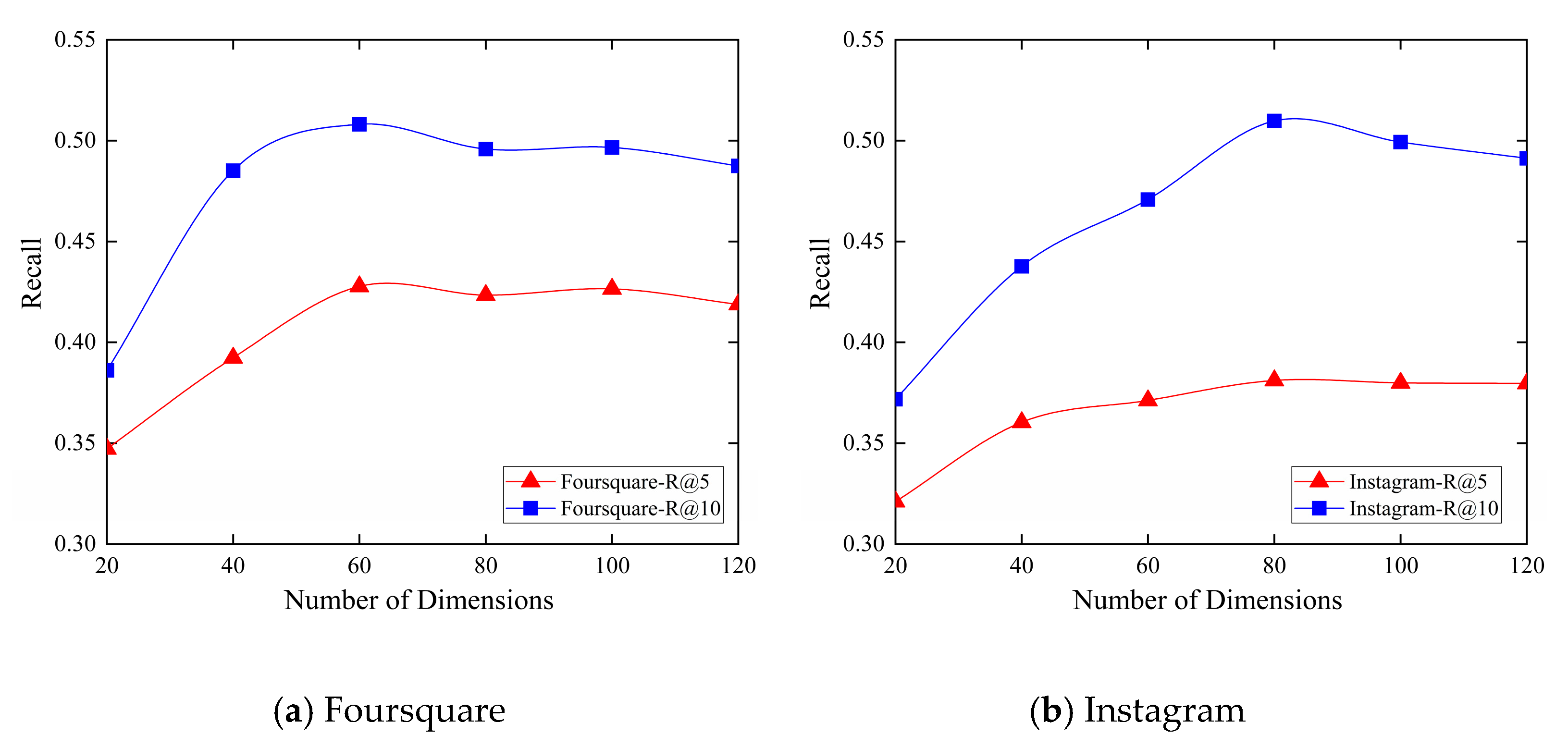
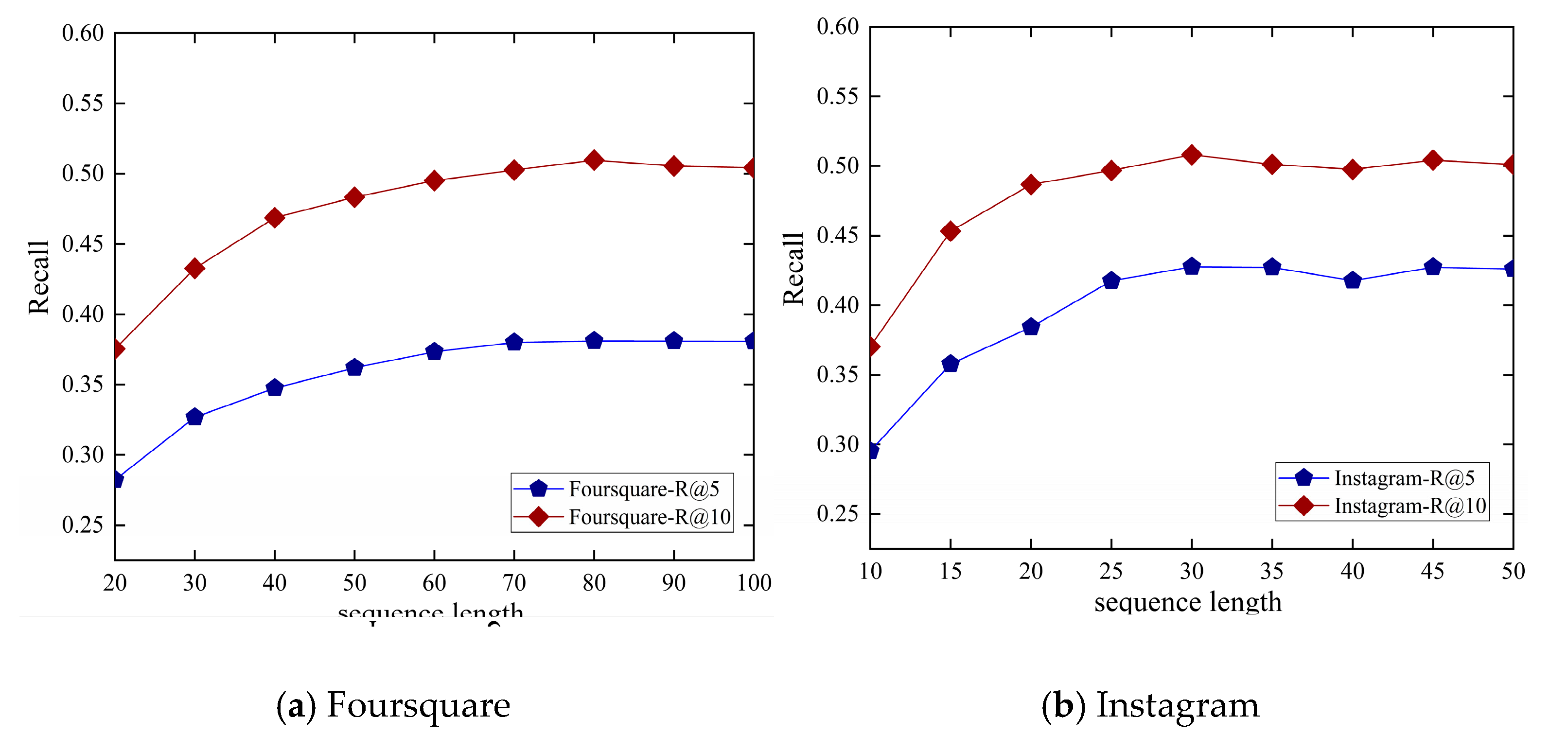
| Statistics | Foursquare | |
|---|---|---|
| #Users | 2293 | 16,889 |
| #POIs | 6870 | 3961 |
| #Check-ins | 385,914 | 278,735 |
| Avg. #check-ins per user | 168.3 | 16.5 |
| Avg. #visited POIs per user | 56.2 | 70.4 |
| sparsity | 97.550% | 99.583% |
| Time span | April 2012–February 2013 | October 2015–September 2016 |
| GRU | Caser | Distance2Pre | ST-RNN | ST-DCGN | |
|---|---|---|---|---|---|
| Foursquare | 1.595 | 1.227 | 2.309 | 2.958 | 1.157 |
| 2.116 | 1.892 | 4.236 | 5.156 | 1.793 |
| 0.1 km | 0.3 km | 0.5 km | 0.7 km | ||
|---|---|---|---|---|---|
| Foursquare | R@5 | 0.3920 | 0.4248 | 0.4277 | 0.4121 |
| F1@5 | 0.1276 | 0.1367 | 0.1426 | 0.1251 | |
| R@5 | 0.3752 | 0.3810 | 0.3793 | 0.3681 | |
| F1@5 | 0.1189 | 0.1270 | 0.1207 | 0.1186 |
© 2020 by the authors. Licensee MDPI, Basel, Switzerland. This article is an open access article distributed under the terms and conditions of the Creative Commons Attribution (CC BY) license (http://creativecommons.org/licenses/by/4.0/).
Share and Cite
Liu, C.; Liu, J.; Xu, S.; Wang, J.; Liu, C.; Chen, T.; Jiang, T. A Spatiotemporal Dilated Convolutional Generative Network for Point-Of-Interest Recommendation. ISPRS Int. J. Geo-Inf. 2020, 9, 113. https://doi.org/10.3390/ijgi9020113
Liu C, Liu J, Xu S, Wang J, Liu C, Chen T, Jiang T. A Spatiotemporal Dilated Convolutional Generative Network for Point-Of-Interest Recommendation. ISPRS International Journal of Geo-Information. 2020; 9(2):113. https://doi.org/10.3390/ijgi9020113
Chicago/Turabian StyleLiu, Chunyang, Jiping Liu, Shenghua Xu, Jian Wang, Chao Liu, Tianyang Chen, and Tao Jiang. 2020. "A Spatiotemporal Dilated Convolutional Generative Network for Point-Of-Interest Recommendation" ISPRS International Journal of Geo-Information 9, no. 2: 113. https://doi.org/10.3390/ijgi9020113
APA StyleLiu, C., Liu, J., Xu, S., Wang, J., Liu, C., Chen, T., & Jiang, T. (2020). A Spatiotemporal Dilated Convolutional Generative Network for Point-Of-Interest Recommendation. ISPRS International Journal of Geo-Information, 9(2), 113. https://doi.org/10.3390/ijgi9020113





